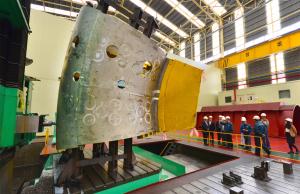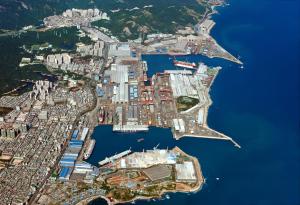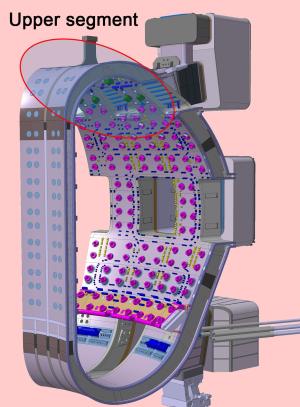Far from ITER, in the heart of the Tokamak
In ITER Member factories on three continents, manufacturing has begun for the components of the ITER Tokamak. Here's a look inside the Hyundai shipyard in Korea where two of the nine ITER vacuum vessel sectors are under construction

We find ourselves in South Korea. But we could just as well be in China, India, Japan, Europe, Russia or the United States—everywhere that ITER components are coming off of manufacturing lines in the factories of the ITER Members.
In Ulsan, South Korea, an industrial city of 1.5 million inhabitants on the south east coast of the peninsula, Hyundai Heavy Industries (HHI) is owner of a vast shipyard, one of the three largest in the world. Several hundred ships of all sizes and shapes (supertankers, gas carriers, luxury liners, container ships ...) are produced here annually.
Not far from the stocking area for the vessels under construction is a vast workshop where a unique piece of equipment is taking shape, unlike anything the company has fabricated previously. Under the tall ceilings of the well-ordered workshop is a large steel structure nearly six metres tall: one of the elements of the ITER vacuum vessel.
The vacuum vessel will be the heart of the ITER machine where, in just a few years, a little Sun will be born within its walls. Not unlike the sections of an orange, the ITER vacuum vessel will be fabricated in nine sectors that, once assembled, will form a torus-shaped structure. Two ITER Members are participating in its fabrication—Korea for two sectors and Europe for nine.
As impressive as the metallic piece before us is, it is only a small upper segment of one of the vacuum vessel sectors under Korean responsibility (see image). Once all the completed pieces are welded together, each sector will be 17 metres tall. These giant components will leave Korea by sea, before travelling to the inland ITER site in southern France by self-propelled transporter.
All of the largest ITER components will follow a similar path before their final assembly in the ITER machine: a long ocean voyage followed by three or four nights of transport between the arrival port on the Mediterranean and the ITER site (see article in this issue: "A successful journey ...").
For Hyundai Heavy Industries, as for all the industrial companies involved with ITER component fabrication, participating in the ITER adventure is both an organizational and a technical challenge. Much is novel about fabrication for ITER, from the special grade of steel produced especially for the Project, to specialized welding techniques, infinitesimal tolerances and drastic quality control procedures.
ITER components are high-technological objects with particularly demanding specifications. Those falling under the category of "Safety Important Component" (like the ITER vacuum vessel) must be the object of particular attention and control. Components will have to pass several levels of quality control procedures. In addition to procedures that are part of the suppliers' fabrication processes, the components will be inspected and controlled by representatives of the Members' Domestic Agencies, the ITER Organization, and—as the machine will operate in France—experts authorized by French nuclear authorities. (Representatives from the French Nuclear Safety Agency, ASN, will visit Hyundai's Ulsan plant in January 2014.)
Fabricating a "piece" of ITER requires submitting to a certain number of obligations for the supplier. But the benefits are clear: by participating in the fabrication of high-tech ITER components, companies have the opportunity to acquire a knowledge base and experience that is precious for its other areas of their activity as well as for future contracts in the domain of fusion.
Byung-Ryul Roh, director of Hyundai's Nuclear Energy Department, agrees: "For our company the ITER contract can be considered 'small,' even if it represents the value of two supertankers. But for the knowledge acquired and the prestige of participating in ITER fabrication, it is a very important contract."
Nearly 10,000 kilometres separate the banks of the Durance River, near ITER, and the Sea of Japan, which the South Koreans call the East Sea. The ITER Project has built a bridge between the two, just as it builds other bridges with China, India, Japan, Russia, the United States and the different nations of Europe where components as technically challenging as the vacuum vessel are currently being fabricated.
Soon, the pieces of this gigantic puzzle will be assembled in Saint Paul-lez-Durance, France. ITER will have then accomplished the first part of its mission—reuniting a large number of the world's nations around a common project—before opening the way to a new source of energy, one that is capable of satisfying, for centuries to come, the energy needs of humanity.



